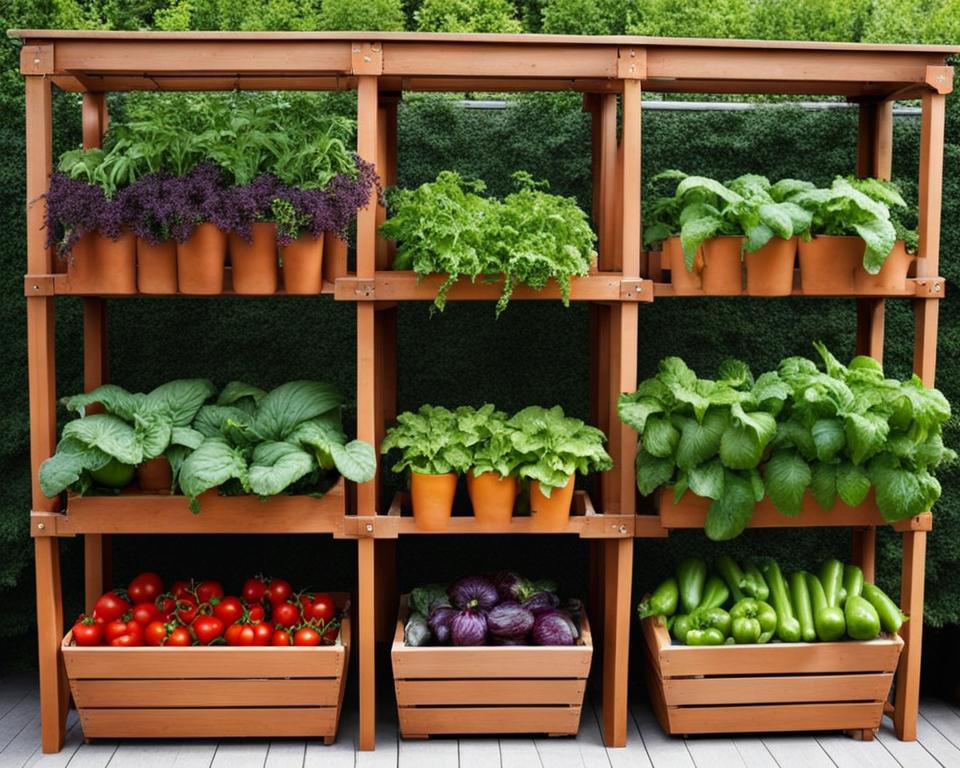Welcome to the world of vertical container vegetable gardening! Have you ever dreamed of growing your own vegetables but feel limited by living in an urban environment with limited outdoor space? Fear not, as this comprehensive guide will introduce you to the innovative and space-efficient technique of vertical container gardening. Perfect for urban gardening enthusiasts, this method offers a practical solution for cultivating a lush vegetable garden on balconies, patios, or any small area. With our expert tips and strategies, you’ll learn how to create a thriving garden oasis in even the most unlikely of places.
Key Takeaways
- Vertical container vegetable gardening is an ideal solution for growing your own produce in small spaces such as balconies and patios.
- Learn the core concepts and benefits of vertical gardening, including how it maximizes space and enhances accessibility.
- Master the art of choosing the right containers, understanding which vegetables thrive in a vertical setting, and designing an aesthetically pleasing garden layout.
- Acquire knowledge in soil and nutrient management, watering techniques, and pest and disease prevention tailored specifically for container gardens.
- Apply the expert tips and strategies shared in this guide to create a flourishing, productive garden oasis no matter your living situation.
Introduction to Vertical Container Vegetable Gardening
Imagine growing a lush, abundant vegetable garden in the smallest of spaces, right on your balcony, patio, or even indoors. This may have seemed impossible at one time, but thanks to vertical gardening and container gardening, it’s now a reality for urban dwellers and those with limited outdoor space. In this section, we’ll introduce you to the world of growing vegetables in containers, where verticality meets sustainability, and every inch of your available space becomes an opportunity to cultivate fresh, organic produce.
Vertical container vegetable gardening combines the principles of vertical gardening, in which plants grow upwards on supports such as trellises and pergolas, and container gardening, where plants are grown in pots or other containers instead of in the ground. This fusion of techniques allows you to make the most of your available space, no matter how limited it may be.
Here are some key benefits of vertical container vegetable gardening:
- Maximizes the use of vertical space, opening up new planting possibilities.
- Provides the flexibility to rearrange container gardens as needed, allowing for a customizable growing environment.
- Allows you to grow a wider variety of vegetables, as specific soil and moisture requirements can be customized for each container.
- Decreases the risk of soil-borne diseases, as container soil is less likely to harbor pathogens.
- Offers easier access to plants for watering, pruning, and harvesting, reducing strain on your back and knees.
How do you get started with vertical container vegetable gardening?
- Choose the right containers:
- Select suitable vegetables:
- Prepare the growing medium:
- Support your plants:
- Maintain your garden:
Opt for containers with ample drainage and made from materials that can withstand outdoor conditions, while also providing an adequate growing environment for your plants, such as clay, plastic, or fabric pots.
Focus on plants that thrive in containers and grow well vertically, such as leafy greens, herbs, tomatoes, peas, and cucumbers.
Use a high-quality potting mix that is well-draining and contains the nutrients your vegetables need to thrive.
Install vertical structures, such as trellises or cages, to support your plants and encourage vertical growth.
Monitor your plants’ health and make adjustments as necessary to watering, fertilization, and pest control practices.
With careful planning, patience, and regular maintenance, you’ll be on your way to a bountiful harvest in no time. Vertical container vegetable gardening isn’t just a trendy gardening hack—it’s a practical and rewarding way to grow your own food, even in the tightest of spaces. So grab your gloves, get your containers, and let’s cultivate the garden of your dreams!
Benefits of Vertical Gardening in Small Spaces
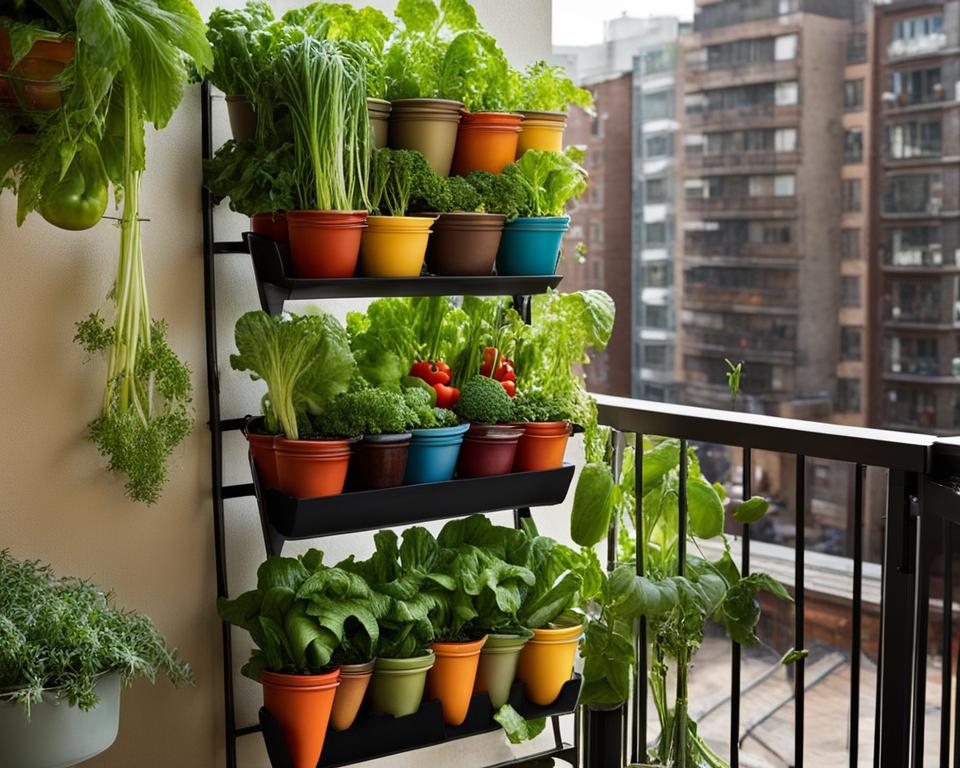
In today’s urbanized world, small space gardening has become essential for those with limited outdoor living areas. Vertical vegetable garden design has emerged as a practical solution to this challenge, offering several benefits that make it ideal for patio gardening, vertical gardening, balcony gardening, and easy maintenance gardening.
Maximizing Your Gardening Area
Vertical container gardening enables you to optimize every inch of your available space, turning walls, trellises, and shelves into lush greenscapes. With this innovative approach, you can grow various types of vegetables in a more confined area, making the most of your urban or small space environment. In addition, it allows you to free up ground space for other purposes, like a lounge area or a cozy conversational spot.
Enhancing Accessibility and Maintenance
Another significant advantage of vertical container gardening is the increased accessibility it offers. By positioning plants at a comfortable height, you can tend to them without excessive bending or kneeling, easing the strain on your back and knees. As a result, the joy of gardening becomes accessible to everyone, regardless of their mobility level.
Maintenance also becomes simpler in a vertical vegetable garden, with plants being more visible and easy to reach. Pruning, harvesting, and caring for your plants can be performed with significantly less effort, while still ensuring your garden remains visually appealing.
Improving Plant Health and Yields
Vertical container gardening provides an optimal environment for plant health, ensuring high yield vegetables. It improves air circulation, reducing the risk of mold and diseases that thrive in humid conditions. Furthermore, better air circulation also helps to keep pests at bay.
Another key benefit of vertical gardening is the increased light exposure, essential for promoting plant growth and photosynthesis. As your plants have more access to sunlight, they will grow stronger and healthier, ultimately producing a bountiful harvest.
“By going vertical, you create a microclimate for each plant, tapping into the natural benefits of improved air circulation and light exposure, which results in a thriving, productive vegetable garden.”
In summary, vertical container gardening is an ideal solution for small space gardening enthusiasts looking to grow their own vegetables. The benefits are numerous, from maximizing growing areas and enhancing accessibility to improving plant health and producing high yields. Embrace this innovative gardening approach and transform your limited outdoor space into a lush and productive haven.
Choosing Containers for Your Vertical Vegetable Garden
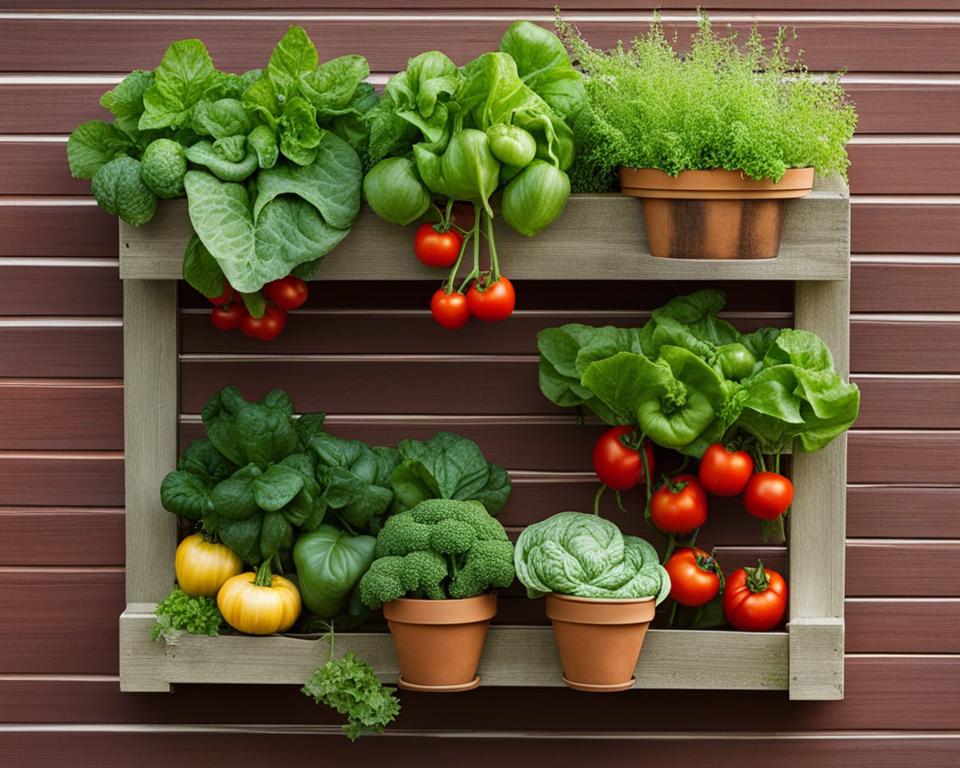
Selecting the right containers is crucial to the success of your vertical container vegetable gardening endeavors. There are various types of containers suitable for vertical gardening, and it’s essential to choose them wisely by focusing on material, size, and functionality. This section will guide you through choosing containers that complement your aesthetic while optimizing plant growth.
Keep the following considerations in mind when choosing containers for your vertical vegetable garden: drainage, size, durability, weight, and aesthetics.
Quality containers are paramount to successful container gardening. To facilitate your decision-making process, here are some popular choices for growing vegetables in containers:
| Container Type | Materials | Advantages | Disadvantages |
|---|---|---|---|
| Terra Cotta Pots | Clay | Traditional look, good drainage, porous | Heavy, breakable, dries out quickly |
| Plastic Pots | Polypropylene, Resin | Lightweight, inexpensive, retains moisture, variety of shapes and sizes | Less durable, can crack or fade in the sun |
| Wooden Containers | Redwood, Cedar | Insulating, attractive, natural look | Can rot, heavier, requires maintenance |
| Fabric Pots | Biodegradable fabric | Lightweight, promotes root air pruning, prevents overwatering | Less durable, may require extra support in vertical configuration |
| Metal Containers | Galvanized steel, tin | Lightweight, unique look, durable | Can heat up quickly, may need lining to avoid rust |
Beyond the material and style, the container size is vital. Remember that a larger container provides more room for root growth, improving the overall health of your plants.
- Consider your plant’s mature size: Opt for a container that’s at least 2 inches deeper and wider than the expected dimensions of your plant’s root system at maturity.
- Plan for root growth: Bigger pots mean more soil capacity, which can improve moisture retention and accommodate a larger root system.
- Adjust for location: When planning your vertical container vegetable garden, consider available space and balance between container size and number of containers. Smaller pots allow more growing opportunities on a single vertical structure, while larger pots may need additional support.
As you progress in container gardening, it’s essential to carefully consider container characteristics that will help your plants thrive. With this knowledge, you can create a vertical container vegetable garden that is beautiful, functional, and bountiful.
Selecting the Best Vegetables for Vertical Gardening
Maximizing food production in limited space requires selecting the right vegetables for your vertical garden. Some plants adapt better to small space gardening and vertical growth than others. In this section, we’ll explore the best leafy greens, herbs, and climbing vegetables to make your vertical garden both attractive and productive.
Leafy Greens and Herbs
An excellent choice for any vertical garden, leafy greens, and herbs are generally easy to grow and maintain in containers. Their shallow root systems and compact growth habit make them perfect for small space gardening. Among the variety of options, some popular choices include:
- Spinach – a fast-growing, nutrient-rich green
- Lettuce – available in different colors and textures, ideal for salads
- Kale – known for its resilience and health benefits
- Mint – a fragrant and versatile herb
- Basil – an essential ingredient in many cuisines
Remember to pick varieties that are well-suited for container growth and can thrive in your specific climate.
Climbing and Vining Vegetables
Making the most of your vertical space is all about embracing climbing and vining vegetables. These plants can be trained to grow using support structures such as trellises, cages, or netting, ultimately turning your small space into a productive and visually stunning edible garden. Some popular climbing and vining vegetables include:
- Tomatoes – both small-fruited and large-fruited varieties
- Peas – snow peas and snap peas are excellent choices
- Cucumbers – try compact bush varieties for containers
- Beans – both pole beans and bush beans work well in a vertical setting
- Small melons – compact varieties can thrive with proper support and care
When selecting vining vegetables for your vertical garden, it’s essential to research each plant’s specific requirements, such as sunlight, water, and temperature, to ensure their successful growth.
| Vegetable | Support Structure | Container Size |
|---|---|---|
| Tomatoes | Cages or trellises | 5-15 gallons, depending on the variety |
| Peas | Netting or narrow trellises | 2-5 gallons |
| Cucumbers | A-frame trellises | 5-12 gallons |
| Beans | Tepee or pole supports | 2-5 gallons |
| Small melons | Strong trellises or slings | 12-20 gallons |
Designing Your Vertical Vegetable Garden Layout
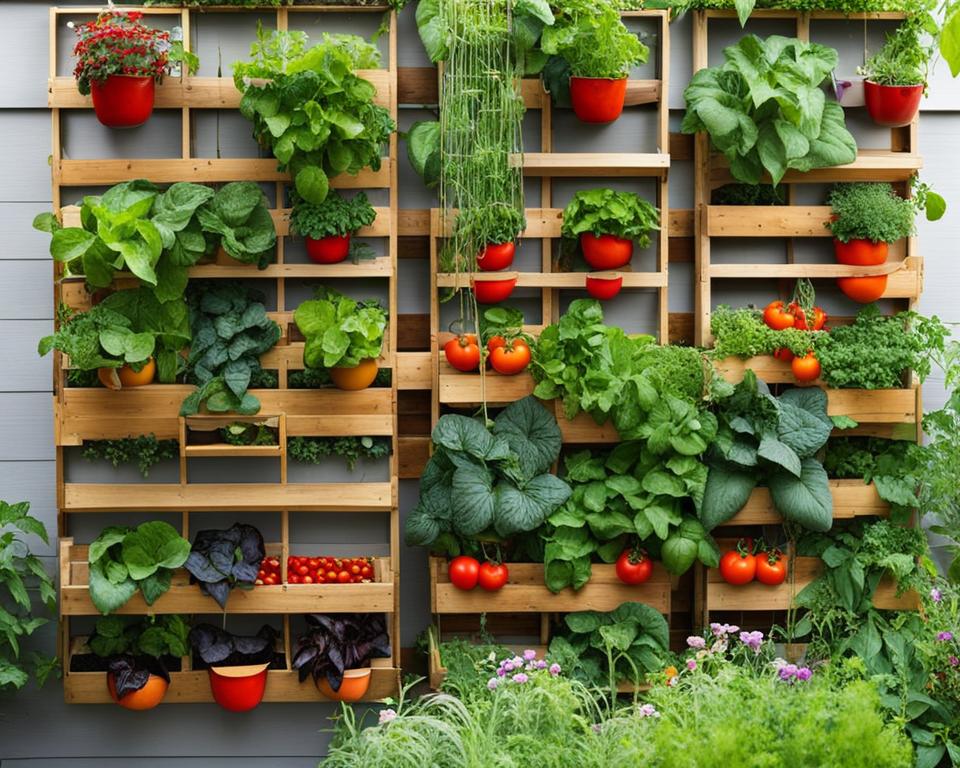
Creating a visually stunning and efficient vertical vegetable garden requires a well-thought-out design. In this section, we’ll explore how to make the most of your available space and create eye-catching arrangements for your vertical container vegetable gardening adventure.
Utilizing Vertical Space Efficiently
Efficient space utilization is at the heart of vertical gardening. By incorporating various vertical structures, you can optimize your garden’s layout by providing support for your container plants while simultaneously enhancing its overall appearance. Consider using trellises, wall-mounted shelves, or hanging baskets as practical and stylish structures for your vertical garden.
Beyond structural elements, it’s essential to consider the placement of your containers to ensure plants receive adequate sunlight and have enough room to grow. Be mindful of plants’ mature sizes and sun requirements when planning your layout. An excellent way to enhance space utilization is to layer containers at different heights, making sure taller plants don’t shade shorter ones.
Lastly, don’t forget to use the vertical surfaces of your home to your advantage. If you’re short on ground space, consider attaching containers to exterior walls, fences, or balcony railings.
Creating Aesthetically Pleasing Arrangements
Vertical container vegetable gardening offers more than just practical benefits; it also presents an opportunity to create a unique and visually engaging garden space that will invite you to spend time amid your healthy harvest. To achieve an aesthetically pleasing design, balance form and function within your layout.
First, think about color harmony. Mixing and matching different colors, textures, and plant shapes can bring visual interest to your garden. Consider placing brightly colored containers together and alternate leaf textures for maximum impact.
Another design consideration involves container size and shape. Use various sizes and shapes of containers to add depth and variety to your garden, creating an eye-catching display. Be sure to choose containers that are both functional and visually appealing, taking into consideration factors such as drainage, durability, and size.
Lastly, pay attention to plant arrangement. Strategically place plants with complementary growth habits together. For example, pair upright and bushy plants with trailing and vining vegetables for an attractive and efficient space utilization.
With careful planning and attention to detail, your vertical vegetable garden will not only provide you with fresh, homegrown produce but also become a captivating focal point in your outdoor space. Embrace the challenges and rewards of vertical container vegetable gardening, and watch your garden soar to new heights!
Soil and Nutrient Management in Container Gardens
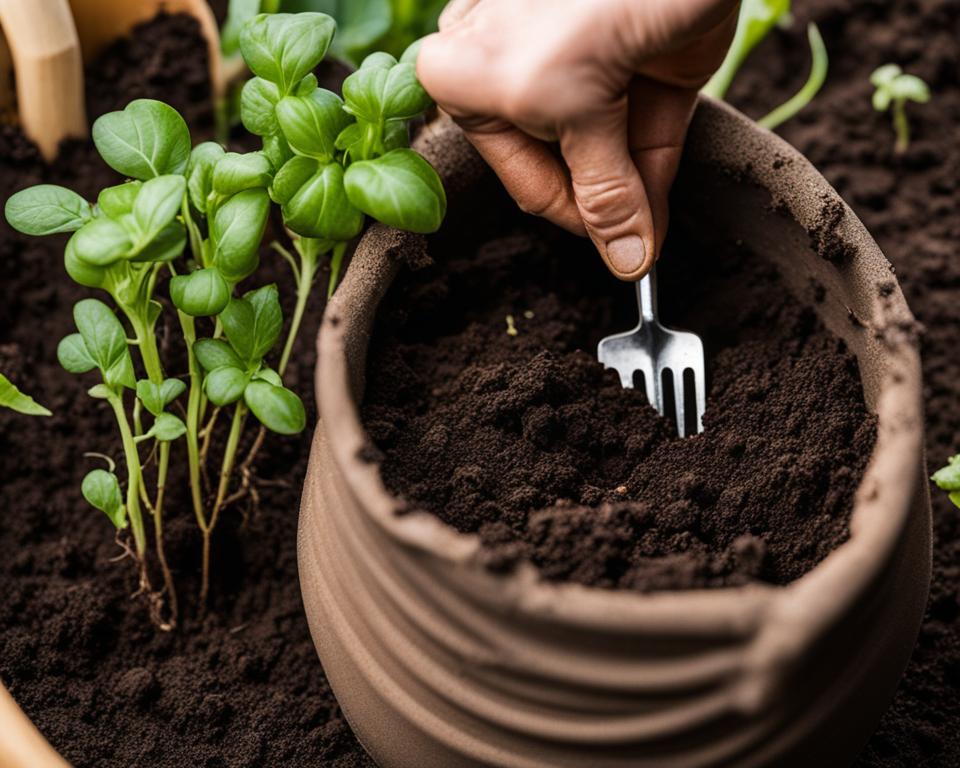
One of the keys to a thriving container vegetable garden is proper soil and nutrient management. Understanding the unique challenges and requirements of container gardening can help you provide the essential elements that your plants need for robust growth. In this section, we’ll delve into the best practices for soil composition and fertilization tailored to container gardens.
Unlike traditional in-ground gardens, container gardening has specific requirements for soil composition. A successful container garden depends on creating a favorable soil environment that provides enough space and nutrients for plant roots to grow. Here are the main factors you should consider when preparing your soil mix:
- Drainage: Soil in containers must have excellent drainage to prevent waterlogged roots, which can lead to root rot. Opt for a soil mix that is specifically designed for container gardening or use a well-draining mix consisting of peat, coco coir, perlite, or vermiculite.
- Aeration: An aerated soil mix allows plant roots to breathe and access sufficient oxygen. You can achieve aeration by adding materials such as perlite, coarse sand, or bark chips to your soil mix.
- Nutrient Retention: Choose a mix that retains moisture and nutrients, providing a constant supply to the plants as needed. Peat moss, coco coir, and compost are all excellent materials for retaining nutrients in container gardens.
Fertilization Strategy
Proper nutrient management plays a vital role in the growth and productivity of your container garden vegetables. Regular fertilization is necessary to maintain the right balance of nutrients in your containers. Here are some best practices to guide your fertilization strategy:
- Begin with a complete organic fertilizer: Pre-mixed organic fertilizers are a convenient, efficient way to provide your plants with essential nutrients. Look for a product that includes nitrogen, phosphorous, potassium, and trace minerals to support balanced plant growth.
- Supplement with a slow-release fertilizer: Add a slow-release granular fertilizer to your soil mix as a long-term nutrient source. This helps to maintain steady nutrient availability for your plants throughout the growing season.
- Use foliar feeding for supplementary nutrients: A liquid fertilizer spray applied directly to the plant leaves can provide additional nutrients to plants experiencing stress or showing signs of deficiency. Ensure you follow the label instructions on the fertilizer to avoid damaging your plants.
- Monitor and adjust fertilizer applications as needed: Keep an eye on your plants for signs of nutrient deficiency or excess. Adapt your fertilization routine based on your plants’ needs to maintain optimal growth and productivity.
“The secret to successful container gardening is striking the right balance between soil composition and nutrient management.”
In conclusion, soil and nutrient management in container gardens are crucial aspects to master for your vertical container vegetable garden to thrive. By following the best practices outlined in this guide, you’ll be well on your way to cultivating healthy, high-yielding plants that make the most of your available space.
Watering Techniques for Container Vegetable Gardens
Effective watering techniques are paramount for container vegetable gardens. Proper hydration is the key to maintaining healthy, thriving plants in your vertical garden. This section provides expert advice on maintaining the right moisture levels, utilizing water-saving methods, and implementing an efficient irrigation system for your vertical vegetable garden design.
Regular and consistent watering is crucial in container gardening, as the limited soil volume means that moisture is depleted more quickly compared to traditional in-ground gardens. The frequency of watering will depend on several factors, such as the size of the container, type of soil, environmental conditions, and the water requirements of each specific vegetable.
General Watering Guidelines:
- Water in the early morning or late afternoon to minimize water loss due to evaporation.
- Use a gentle watering method, such as a watering can with a fine spray nozzle, or a drip irrigation system to avoid dislodging soil and damaging plant roots.
- Water deeply and slowly, allowing the water to reach the root zone.
- Do not overwater—excessive moisture can lead to root rot and diseases.
Conserving water is not only environmentally responsible, but it also ensures that your plants receive the necessary moisture without wasting resources.
“The best way to conserve water is to be smart about how and when we use it. By following a few simple steps, we can protect our valuable water resources and ensure that our plants are watered effectively.”
Water-Saving Methods:
- Group plants with similar water requirements together.
- Add a layer of mulch to the top of the soil to retain moisture and prevent evaporation.
- Choose drought-tolerant vegetable varieties when possible.
- Use a moisture meter to determine the actual moisture content of the soil prior to watering.
Furthermore, automating the watering process can be highly beneficial if you have multiple vertical vegetable gardens or are short on time.
Efficient Irrigation System Designs for Vertical Gardens
An effective irrigation system will reduce water consumption while providing the optimal level of hydration for your vertical vegetable garden. Consider the following systems for your container gardening setup:
| Irrigation System | Pros | Cons |
|---|---|---|
| Drip Irrigation |
|
|
| Soaker Hoses |
|
|
| Self-Watering Containers |
|
|
With the right watering techniques and an efficient irrigation system in place, your vertical vegetable garden will flourish, providing you with a bountiful harvest. By taking the time to understand your plants’ water needs and utilizing water-saving methods, you can ensure the health and well-being of your container garden, all while reducing your ecological footprint.
Managing Pests and Diseases in a Vertical Setting
While vertical container vegetable gardening offers many advantages, it is not immune to pests and diseases. Ensuring the health and productivity of your garden is crucial, and this section will guide you through the necessary steps for effective pest management and disease prevention in your vertical garden.
Preventative Measures for a Healthy Garden
Prevention is always the first line of defense when it comes to maintaining a healthy garden. By adopting certain practices and techniques, you can minimize the risk of pests and diseases harming your plants. Here are some essential preventative measures:
- Choose healthy plants: Always start with healthy, disease-free plants or seeds from reputable sources. Weak or infected plants are more susceptible to pests and diseases.
- Ensure proper air circulation: Adequate spacing between plants allows for better airflow, reducing the risk of diseases caused by excessive moisture and humidity.
- Use quality soil and containers: Invest in well-draining soil and containers with drainage holes to prevent waterlogging, which can lead to root rot and other diseases.
- Practice crop rotation: Rotate your vegetable crops between different containers or sections of your vertical garden to disrupt the life cycles of pests and diseases.
- Keep your garden clean: Regular cleaning and maintenance helps prevent the buildup of pests and diseases. Remove dead leaves, weeds, and other debris from your gardening space.
Even with the best prevention practices in place, pests and diseases may still find their way into your garden. It’s important to monitor your plants regularly and act swiftly should you notice any signs of infestation or disease.
“An ounce of prevention is worth a pound of cure. By being proactive and vigilant, you can prevent many pests and diseases from taking hold in your vertical garden.”
Pest and disease control methods vary depending on the specific issue you’re facing. Below, we’ve compiled a table with some common pests and diseases in vertical container vegetable gardens, along with suggested organic and environmentally friendly approaches for managing them.
| Problem | Environmentally Friendly Solution |
|---|---|
| Aphids | Release ladybugs or lacewings, or apply insecticidal soap |
| Whiteflies | Set up yellow sticky traps or use insecticidal soap |
| Spider Mites | Apply neem oil, use a strong water spray to dislodge mites, or introduce predatory mites |
| Slugs and Snails | Set up beer traps or use copper tape around your containers |
| Early Blight (a fungal disease) | Apply organic fungicides, such as copper-based sprays |
| Powdery Mildew (a fungal disease) | Apply a mixture of baking soda, water, and dish soap |
Note that these suggestions are not exhaustive, and treatment options may vary based on the specific nature of your garden and its environment. Always research and choose the most appropriate measures for your particular situation.
By implementing these preventative and responsive measures, you can effectively manage pests and diseases, ensuring a vibrant and healthy vertical container garden all year round.
Conclusion
As we reach the end of this guide, it’s evident that vertical container vegetable gardening offers numerous benefits and opportunities for successful urban gardening, regardless of your available space. By following the expert advice, tips, and strategies we’ve outlined throughout this comprehensive guide, it’s clear you can easily cultivate a thriving vegetable garden even in the smallest of areas.
From selecting the right containers and vegetables for your vertical garden to mastering essential designs, soil and nutrient management, watering techniques, and pest control methods, you’re now well equipped to embark on your own journey towards creating a green oasis in your urban or small-space environment. Remember, efficient space utilization, proper plant selection, and adequate care are the key ingredients for a successful vertical container vegetable garden.
In summary, vertical container vegetable gardening not only transforms limited spaces into lush, productive gardens but provides you with the joy of harvesting your own fresh produce right at home. Embrace the power of growing upwards, and watch your small space flourish into a thriving and bountiful harvest.
FAQ
What is vertical container vegetable gardening?
Vertical container vegetable gardening is an innovative technique that combines the principles of vertical gardening and container gardening to grow vegetables in small spaces like balconies, patios, and urban gardens. This approach makes efficient use of vertical space by stacking or hanging containers, allowing gardeners to cultivate a variety of vegetables in limited areas.
Are there any benefits to vertical gardening in small spaces?
Yes, vertical gardening offers several benefits when it comes to small spaces, such as maximizing your gardening area, enhancing accessibility and maintenance, and improving plant health and yields. Vertical gardens make it possible to grow a variety of vegetables in limited spaces, reduce the workload, and promote healthy plants with better air circulation and light exposure.
How do I choose the right containers for my vertical vegetable garden?
To choose the right containers for your vertical vegetable garden, consider factors like material, size, and functionality. Some suitable materials for containers include plastic, fabric, terracotta, and metal. Choose containers that have adequate space for root growth and ensure they have drainage holes. Additionally, consider your garden’s aesthetic and overall design when selecting containers.
Which vegetables are best suited for vertical gardening?
Some vegetables that are well-suited for vertical gardening include leafy greens and herbs, such as lettuce, kale, basil, and parsley. Climbing and vining vegetables like tomatoes, peas, cucumbers, and beans are also ideal for vertical gardens, as they can be trained to grow on trellises, fences, or other structures.
How can I design an efficient and visually appealing vertical vegetable garden layout?
To create a functional and attractive vertical vegetable garden layout, efficiently utilize your vertical space with structures like shelves, trellises, and hanging planters. Consider the sunlight and airflow requirements of each plant when arranging them. Additionally, balance form and function by incorporating visually appealing elements like colorful containers, interesting plant combinations, and varied heights to create an engaging garden space.
What are the best practices for soil and nutrient management in container gardens?
In container gardens, ensure you use a high-quality, well-draining soil mix that is rich in organic matter. Regularly monitor your plants for any signs of nutrient deficiency, and apply an appropriate slow-release or liquid fertilizer according to your vegetables’ specific needs. Make sure not to over-fertilize, as this can lead to poor plant growth.
How should I water my container vegetable garden?
Watering techniques for container vegetable gardens include maintaining consistent moisture levels, using water-saving methods like mulching, and installing efficient irrigation systems like drip or soaker hoses. Make sure to water your plants at the root level, avoid wetting the foliage, and adjust your watering schedule based on environmental conditions and each plant’s specific needs.
How can I manage pests and diseases in my vertical container garden?
Effective pest and disease management in your vertical container garden involves implementing preventative measures like rotating crops, using disease-resistant varieties, monitoring for pests, and maintaining good garden hygiene. If you notice any pests or diseases, take prompt action by removing affected plants and using organic or environmentally friendly treatments as needed while avoiding harmful chemicals.

